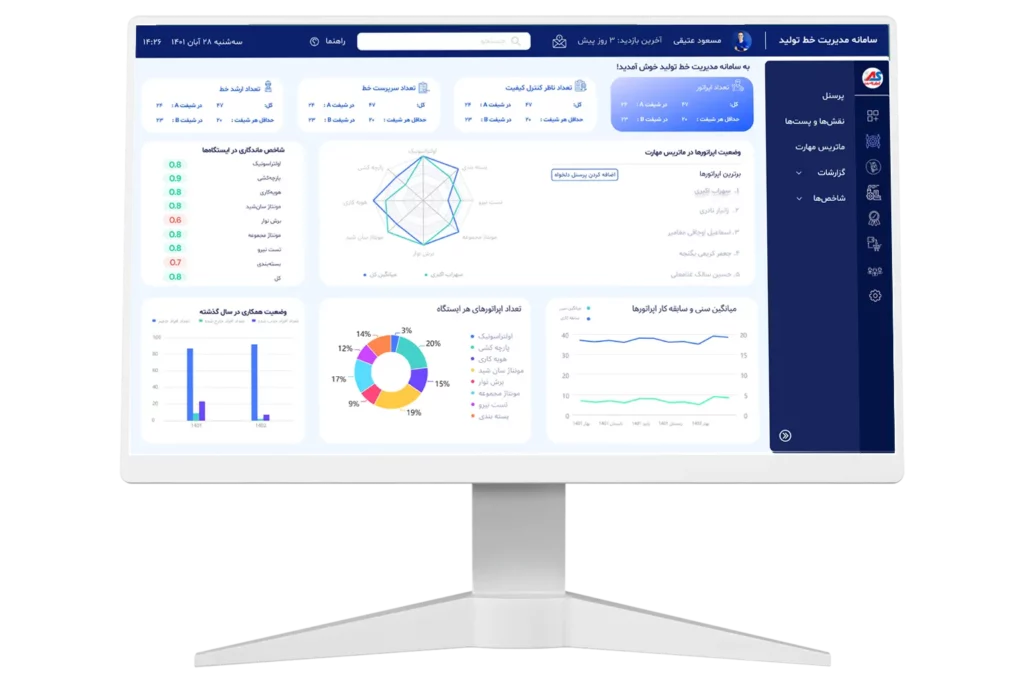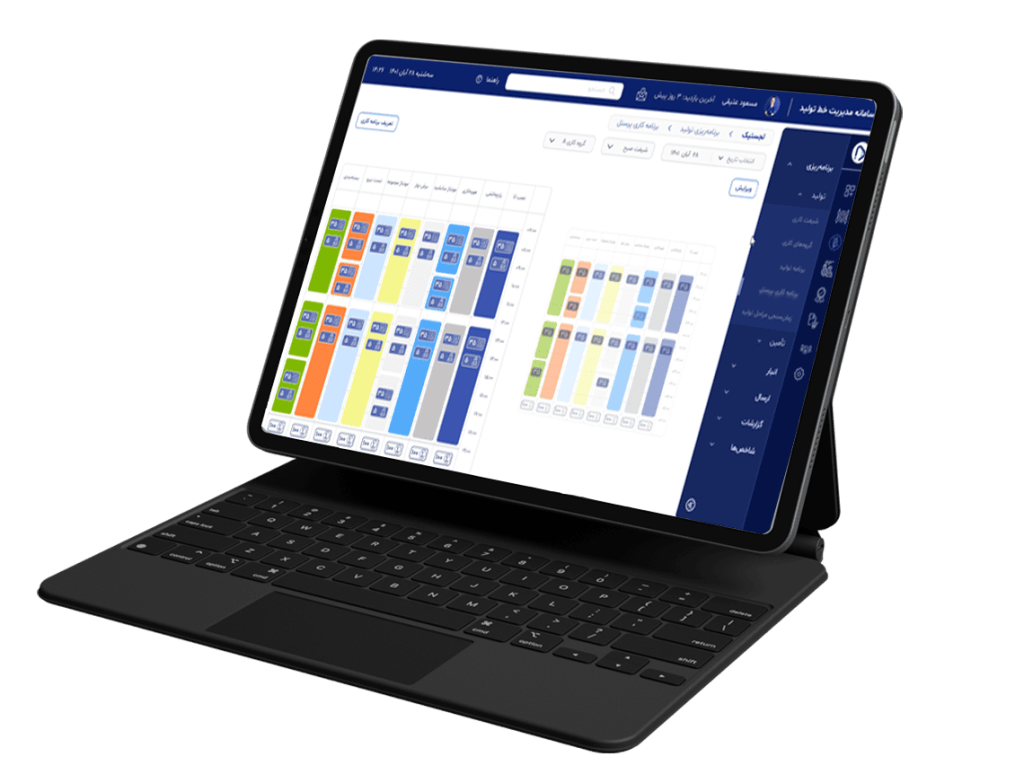Production line management software is a key tool for optimizing production processes in factories, which includes capabilities such as production planning and scheduling, monitoring machinery performance, inventory management, and quality control.
By providing accurate data and analytical reports, this software helps managers make more informed decisions and reduce costs by minimizing resource wastage and increasing productivity.
As a result, using this software allows companies to perform better in today’s competitive world and improve the quality of their products.



Recording the entry and exit information of personnel in the production line and monitoring their performance
The human resources module allows users to register the identity, education and work information of the production line personnel and define the current roles and posts in the system. Job descriptions for all positions in the organization, including job duties, responsibilities, and requirements for each role, are recorded in this section. The skill matrix of production line operators in different stations and activities is determined and their performance reports are available to production planning experts.
Logistics module includes production planning, supply planning, warehouse and shipping sub-modules. Using this module, production planning users can define and record the production plan and work schedule of production line operators. Supply planning users can also send a request for supply of raw materials needed for production to the Department of Commerce using this module. In the warehouse section, the general information of the raw materials used in the production lines and warehouses in the factory are defined and the online inventory of the goods can be seen. How to package final products and how to send to customers can also be accessed in the shipping section. Additional reports related to the processes of the mentioned parts can also be accessed and viewed.
In the production module, experts can access the online dashboard of the production status and monitor the production rate and the performance of the personnel at the workstations in real time. The final product tracking report, which is one of the most important concerns of business owners and factories, is presented to users in this module in a comprehensive and practical way. It is also possible to announce technical faults and stop the production line, and additional reports of these cases will be available to users. In case of testing the final product, it is possible to record and save the rese tests in the software and its supplementary reports.
In the quality module, it is possible to set up a production line and record its conditions for users. Quality experts can record suspicious or non-conforming items of the production line as well as the amount of waste. In this module, it is also possible to announce line quality defects, stoppages caused by it, and assignment of suspicious cases. Ensuring the quality of the final product or sub-products in the production line is also one of the important parts of this module for users.
The users of the business module have the possibility to view the supply requests of the supply planning department and convert them into final orders. Returning non-conforming items in the raw materials received from the supplier can also be done in this module.
In this module, users can track all factory assets in one place. This module can help track the location, usage and maintenance history of each asset, making it easy to identify and resolve issues quickly. This module helps users to proactively plan maintenance activities and reduce the risk of equipment failure and downtime.
Definition of technical identification of equipment (manufacturer, model, serial number and class)
Viewing records of repairs and moving equipment (equipment location, process change)
Ability to register purchase invoices for each device
The possibility of allocating consumable parts of each asset
Add files such as brochures and asset maintenance instructions
Attach related documents, repair and safety files and calibration
Arranging and planning preventive agendas
Automatically create task triggers based on time, reported values, or events
Identifying the root of equipment failure and determining corrective measures on them
The human resources module allows users to register the identity, education and work information of the production line personnel and define the current roles and posts in the system. Job descriptions for all positions in the organization, including job duties, responsibilities, and requirements for each role, are recorded in this section. The skill matrix of production line operators in different stations and activities is determined and their performance reports are available to production planning experts.
Logistics module includes production planning, supply planning, warehouse and shipping sub-modules. Using this module, production planning users can define and record the production plan and work schedule of production line operators. Supply planning users can also send a request for supply of raw materials needed for production to the Department of Commerce using this module. In the warehouse section, the general information of the raw materials used in the production lines and warehouses in the factory are defined and the online inventory of the goods can be seen. How to package final products and how to send to customers can also be accessed in the shipping section. Additional reports related to the processes of the mentioned parts can also be accessed and viewed.
In the production module, experts can access the online dashboard of the production status and monitor the production rate and the performance of the personnel at the workstations in real time. The final product tracking report, which is one of the most important concerns of business owners and factories, is presented to users in this module in a comprehensive and practical way. It is also possible to announce technical faults and stop the production line, and additional reports of these cases will be available to users. In case of testing the final product, it is possible to record and save the rese tests in the software and its supplementary reports.
In the quality module, it is possible to set up a production line and record its conditions for users. Quality experts can record suspicious or non-conforming items of the production line as well as the amount of waste. In this module, it is also possible to announce line quality defects, stoppages caused by it, and assignment of suspicious cases. Ensuring the quality of the final product or sub-products in the production line is also one of the important parts of this module for users.
The users of the business module have the possibility to view the supply requests of the supply planning department and convert them into final orders. Returning non-conforming items in the raw materials received from the supplier can also be done in this module.
In this module, users can track all factory assets in one place. This module can help track the location, usage and maintenance history of each asset, making it easy to identify and resolve issues quickly. This module helps users to proactively plan maintenance activities and reduce the risk of equipment failure and downtime.
Definition of technical identification of equipment (manufacturer, model, serial number and class)
Viewing records of repairs and moving equipment (equipment location, process change)
Ability to register purchase invoices for each device
The possibility of allocating consumable parts of each asset
Add files such as brochures and asset maintenance instructions
Attach related documents, repair and safety files and calibration
Arranging and planning preventive agendas
Automatically create task triggers based on time, reported values, or events
Identifying the root of equipment failure and determining corrective measures on them
Production line management software is specifically designed to optimize and control production processes. This software allows organizations to be aware of production status in real-time, analyze data related to the performance of machinery, labor and raw material inventory. Using advanced algorithms and machine learning, this software is able to provide accurate predictions about production needs, maintenance and repair times, as well as machine productivity. These features help reduce downtime and increase overall production line efficiency.
Also, one of the main advantages of production line management software is the ability to accurately track and record production processes from the beginning of work to the final product. This tracking can include recording product quality, production time and costs. With this information, companies can make better decisions about quality management and continuous improvement. In addition, these softwares provide detailed reporting and management dashboards that allow managers to evaluate production line performance in real time and identify strengths and weaknesses. As a result, these softwares help to increase profitability and improve customer experience.
۱٫ Optimizing processes: production line management software provides the possibility of detailed analysis of production processes. By identifying unnecessary or inefficient steps, companies can easily optimize these steps and reduce time and costs.
2. Increasing productivity: These softwares help managers to make timely corrective decisions by providing real-time data about the performance of machinery and labor. This increase in productivity means more production in less time and with fewer resources.
3. Quality management: With monitoring and quality control capabilities, the software provides the possibility of recording and tracking the quality of products at every stage of production. This feature helps to identify problems before reaching the final stage of production and reduces risks related to the final product.
4. Reduction of downtimes: The aforementioned softwares help predict maintenance needs. By regularly scheduling repairs and maintenance, companies can minimize unexpected downtime and avoid sudden production line shutdowns.
5. Improving decision-making: The data collected from the production line allows managers to make more informed decisions. Analytical reports and management dashboards allow them to identify trends and patterns and implement continuous improvements in production processes.
6. Integration with other systems: Production line management software usually has the ability to integrate with other systems such as ERP and CRM. This integration allows information to flow more effectively throughout the organization and strengthen collaboration between different departments.
7. Increasing customer satisfaction: By improving quality and reducing delivery time, production line management software helps to increase customer satisfaction. This can lead to increased customer loyalty and improved brand reputation.
8. Data analysis: The use of advanced data analysis techniques allows companies to predict production and demand trends. These predictions can help in better planning of production and warehousing.
9. Increasing transparency: These softwares increase transparency in the organization by providing a clear view of all production stages. This transparency allows managers to easily identify weaknesses and implement necessary improvements.
Due to these advantages, production line management software are considered key tools for any manufacturing organization that help optimize performance and achieve better results.
To use the production line management software, depending on the specific production needs and the type of software, various hardware may be required. Here are some of the main hardware required to run a production line management system:
1. Barcode scanners: In order to track products and record the information of each stage of production, fixed or manual barcode scanners are necessary to read product barcodes.
2. Industrial computers or panel PCs: these devices are placed near the production line and are used to display real-time data and control different parts of production. PC panels can be used for better employee interaction with the software.
3. Networking (routers and switches): Appropriate network equipment is needed to connect different production devices to the central server and transfer data to the management software. In some cases, wireless networks can also be useful.
4. Servers: To store and process production data, a central server or cloud space is needed to maintain production line information and run software.
5. Sensors and IoT devices: If the software is designed to monitor equipment or collect data through sensors or IoT devices, these hardwares are necessary to collect data from production equipment.
6. Machine vision cameras: If you provide an automatic quality measurement system using machine vision, industrial quality cameras will also be needed.
7. Various interfaces (digital/analog inputs and outputs): If you need to connect directly to production machinery, you will need interface equipment to send and receive production line control data.
info@dinaeam.com
برای استفاده از دمو نرم افزارهای دینا فرم زیر را تکمیل فرمایید.
